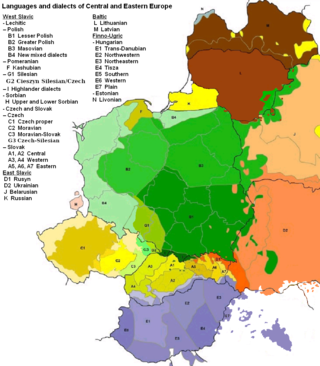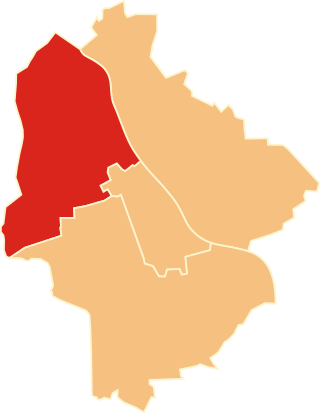
Silesia is a historical region of Central Europe that lies mostly within Poland, with small parts in the Czech Republic and Germany. Its area is approximately 40,000 km2 (15,400 sq mi), and the population is estimated at 8,000,000. Silesia is split into two main subregions, Lower Silesia in the west and Upper Silesia in the east. Silesia has a diverse culture, including architecture, costumes, cuisine, traditions, and the Silesian language. The largest city of the region is Wrocław.

Silesian, occasionally called Upper Silesian, is an ethnolect of the Lechitic group spoken by part of people in Upper Silesia. Its vocabulary was significantly influenced by Central German due to the existence of numerous Silesian German speakers in the area prior to World War II and after. The first mentions of Silesian as a distinct lect date back to the 16th century, and the first literature with Silesian characteristics to the 17th century.

The Province of Lower Silesia was a province of the Free State of Prussia from 1919 to 1945. Between 1938 and 1941 it was reunited with Upper Silesia as the Province of Silesia. The capital of Lower Silesia was Breslau. The province was further divided into two administrative regions (Regierungsbezirke), Breslau and Liegnitz.
Trans-Olza, also known as Trans-Olza Silesia, is a territory in the Czech Republic which was disputed between Poland and Czechoslovakia during the Interwar Period. Its name comes from the Olza River.

The Upper Silesian Industrial Region is a large industrial region in Poland. It lies mainly in the Silesian Voivodeship, centered on Katowice.

Silesian Military District was one of three military districts in Poland, the other two being the Pomeranian Military District and the Warsaw Military District. All three were disbanded by the end of 2011 due to the restructuring of the Polish Army. Its headquarters was in Wrocław.

Białystok Voivodeship was an administrative division and local government in Poland from 1944 to 1975, when its purview was separated into eastern Suwałki Voivodeship, Łomża Voivodeship and Białystok Voivodeship (1975–1998). Its capital city was Białystok. The establishment of Podlaskie Voivodeship in 1999 was essentially a reunion of the areas of Białystok Voivodeship (1945–1975).

The Czechoslovak-Polish War, widely known in Czech sources as the Seven-Day War was a military confrontation between Czechoslovakia and Poland over the territory of Cieszyn Silesia in early 1919.
The Warsaw Military District was one of three military districts in Poland, the other two being the Pomeranian Military District and the Silesian Military District. It was the regional executive body of the Ministry of National Defense of Poland in the capital of Warsaw in operational and defense matters and military administration existing from 1945 to 1998.

The District of Western Pomerania, also designated as the 3rd District, was a district of Poland, during the administration of the Provisional Government of the Republic of Poland in 1945, and the Provisional Government of National Unity from 1945 to 1946. It was established as one of four districts on 14 March 1945, as one of the four districts created to administer the area known as the Recovered Territories, acquired by Poland from Nazi Germany, during, and in the aftermath of World War 2. It was formed within the boundaries of former German provinces of Brandenburg, and Pomerania, and consisted of the area of the Farther Pomerania and Lubusz Land. On 25 September 1945, its southern part was incorporated into the Poznań Voivodeship. It existed until 28 June 1946, when it was abolished and incorporated into the Szczecin Voivodeship.

The Lower Silesian District, also designated as the 2nd District, was a district that acted as an provisional administrative division of Poland, during the administration of the Provisional Government of the Republic of Poland in 1945, and the Provisional Government of National Unity from 1945 to 1946. It was centered around the area of the Lower Silesia. It was established as one of four provisional districts on 14 March 1945. On 25 September 1945, the territories near its northern border were incorporated into the Poznań Voivodeship. It existed until 28 June 1946, when it was abolished and replaced with the Wrocław Voivodeship. The head of the district was the attorney-in-fact Stanisław Piaskowski.

The Masurian District, also known as the District of East Prussia, and designated as the 4th District, was a district that acted as an provisional administrative division of Poland, during the administration of the Provisional Government of the Republic of Poland in 1945, and the Provisional Government of National Unity from 1945 to 1946. It was centered around the areas of Masuria, Powiśle and Warmia.

The Gdańsk Voivodeship was a voivodeship (province) with capital in Gdańsk, that was located in the region of Pomerelia. It existed from 1945 to 1975. Until 28 June 1945, it remained under the administration of the Provisional Government of the Republic of Poland, which then was replaced by the Provisional Government of National Unity. On, 19 February 1947, the provisional government was replaced by the Polish People's Republic. It was established on 7 April 1945, from the parts of the territories of the Pomeranian Voivodeship, and the Masurian District, Poland. The voivodeship ceased to exist on 31 May 1975, when it was partitioned by then-established voivodeships of Elbląg, Gdańsk, and Słupsk.

The North Warsaw County was a county within the city of Warsaw. It existed from 1928 to 1939, and from 1944 to 1960, as a county of Warsaw, that functioned as the voivodeship. From 1928 to 1939, it was under the administration of the Second Polish Republic, from 1944 to 1945, under the Provisional Government of the Republic of Poland, from 1945 to 1947, under the Provisional Government of National Unity, and from 1947 to 1960, under the Polish People's Republic.

The South Warsaw County was a county within the city of Warsaw. It existed from 1928 to 1939, and from 1944 to 1960, as a county of Warsaw, that functioned as the voivodeship. From 1928 to 1939, it was under the administration of the Second Polish Republic, from 1944 to 1945, under the Provisional Government of the Republic of Poland, from 1945 to 1947, under the Provisional Government of National Unity, and from 1947 to 1960, under the Polish People's Republic.

The Warsaw Downtown County was a county within the city of Warsaw. It existed from 1931 to 1939, and from 1944 to 1960, as a county of Warsaw, that functioned as the voivodeship. From 1931 to 1939, it was under the administration of the Second Polish Republic, from 1944 to 1945, under the Provisional Government of the Republic of Poland, from 1945 to 1947, under the Provisional Government of National Unity, and from 1947 to 1960, under the Polish People's Republic.
The West Warsaw County was a county within the city of Warsaw. It existed from 1944 to 1960, as a county of Warsaw, an independent city, that functioned as a voivodeship. From 1944 to 1945, it was under the administration of the Provisional Government of the Republic of Poland, from 1945 to 1947, under the Provisional Government of National Unity, and from 1947 to 1960, under the Polish People's Republic.
The Warsaw Praga-Północ County was a county within the city of Warsaw. It existed from 1944 to 1960, as a county of Warsaw, an independent city, that functioned as a voivodeship. From 1944 to 1945, it was under the administration of the Provisional Government of the Republic of Poland, from 1945 to 1947, under the Provisional Government of National Unity, and from 1947 to 1960, under the Polish People's Republic.
The Warsaw Praga-Południe County was a county within the city of Warsaw. It existed from 1944 to 1960, as a county of Warsaw, an independent city, that functioned as a voivodeship. From 1944 to 1945, it was under the administration of the Provisional Government of the Republic of Poland, from 1945 to 1947, under the Provisional Government of National Unity, and from 1947 to 1960, under the Polish People's Republic.

The Silesian Voivodeship, also known as the Basin–Silesian Voivodeship, and the Silesian–Dąbrowa Voivodeship, was a voivodeship (province) of Poland, with capital in Katowice, that existed from 1945 to 1950. It was located in the Upper Silesia. The voivodeship was established in 1945 and until 28 June 1945, remained under the administration of the Provisional Government of the Republic of Poland, which then was replaced by the Provisional Government of National Unity. On, 19 February 1947, the provisional government was replaced by the Polish People's Republic. On 28 June 1946, the District of Opolian Silesia had been incorporated into the voivodeship. It existed until 6 July 1950, when it was partitioned into the voivodeships of Katowice and Opole.














